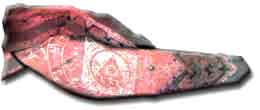
Recruitment and Beginnings
Arrival from Manila
The First Martyrs
Amulets and Anting-anting
April 3, Palm Sunday
Massing of Forces
First Encounter
Revolutionaries Gain Ground
The Retreat Begins
Betrayal and Death
Regrouping in the Mountains
Final Victory
The Author
Arrival from Manila
The First Martyrs
Amulets and Anting-anting
April 3, Palm Sunday
Massing of Forces
First Encounter
Revolutionaries Gain Ground
The Retreat Begins
Betrayal and Death
Regrouping in the Mountains
Final Victory
The Author
 AMULETS are part of the Filipino's arsenal of defenses against unknown forces in a world he knows very little about and which he is afraid of. In the Cebuanos' struggle against the Spanish tyranny, the odds were stacked against the local katipunan forces. They barely had time to organize themselves before they were discovered and some top leaders were arrested. They were ill-equipped to fight against a better-organized, better-armed and better-fed Spanish troops.
AMULETS are part of the Filipino's arsenal of defenses against unknown forces in a world he knows very little about and which he is afraid of. In the Cebuanos' struggle against the Spanish tyranny, the odds were stacked against the local katipunan forces. They barely had time to organize themselves before they were discovered and some top leaders were arrested. They were ill-equipped to fight against a better-organized, better-armed and better-fed Spanish troops.
Rather than plunge into suicidal attacks against their enemies, it became necessary for the local revolutionaries to have a psychological prop to strengthen their resolve to fight. With Leon Kilat who had shown an extraordinary prowess, their handicap was solved.
Relatives in Bacong, Negros Oriental would testify that Leon Kilat had the uncanny ability to appear in places from seemingly out of nowhere and disappear, using his handkerchief like a magic carpet. Thus the name "Kilat" (lightning).
"Si Leon Kilat dunay hiyas nga nabantug ug gikaintapan sa mga kaaway (Leon Kilat had this quality which was reknowned and feared by his enemies)," recalled Andres Abellana 30 years after the revolution.
"Ako, nakakita gayud. Moasdang siya sa mga kaaway bisan naghadyong ang mga bala. Makuli nga maigo ug kon maigo man gani, maorag dili siya dutlan kay mamapha lang ug dili maunsa," added Abellana.
(I really saw it myself. He would advance towards his enemies even with bullets buzzing around him. It would be difficult to hit him. Or, even if he is hit, he simply dusts himself and he is not even hurt.)
But unlike others who are said to possess amulets, Leon willingly shared his ability with fellow katipuneros to shield them in battle. Whether or not these were actually effective did not seem to matter then. The katipuneros apparently believed they became invulnerable to bullets like their leader, and that kind of belief was important if they were to win their battles against the superior weapons of the Spanish guardia civil, cazadores and voluntarios locales.
First was the vistidora, a chasuble-like cloth worn over one's clothes. Printed on it were synbolic words and religious pictures and corrupted Latin and Spanish words and phrases.
The frontal part had God the Father's image at the upper portion, accompanied by images of the resurrection of Jesus Christ, heads of the Three Persons, the heads of the 12 Apostles, angels, archangels and seraphims carrying swords and chalices.
Corrupted Latin and Spanish words - like Cruz passion y muerte cruz de Cristo salva mi tress Ave Maria, Adit Dium Empacturom en visto virgo Jesus Jesus - completed the chasuble's front.
The back part of the clothing also bore the image of God the Father at the uppermost portion, with the images of St. James the Apostle and St. Michael, both riding horses and carrying swords, occupying the lower part. While at the center lowermost portion was the palm of the right hand which had the usual Latin and Spanish inscriptions.
Another amulet was a triangle-shaped clothing inscribed with several words and numbers and divided into nine smaller triangles. "Gibison Gaodio magnobaldi contra bala epica egosom pactom Dominom Diom Pactom Jesom Pleom Tom Jesus" were some of the words found in that piece of clothing. This was wound around the katipunero's head to shield him from head injuries.
 A substitute was a small triangular piece of cloth or paper on which the magical words have been written. This was attached to the brim of the hat.
A substitute was a small triangular piece of cloth or paper on which the magical words have been written. This was attached to the brim of the hat.
A third clothing, about two fingerbreadths in width, had the image of an angel carrying a kris, with the following Spanish words: "Salvate Deus, Los que defienden de la patria como nuestro defensa en la patria celestial contra los demonios."
The local katipuneros were also made to place inside their mouths a round piece of paper about the size of one peso, with the following words inscribed in the center: Hiesus lamuroc milano. Around the paper were written: "Panes teurom nam butrates luz itirre quetram bobis viva buturiam." At the other side of that paper was written the letters K.K.K. It was called hostia redentora and believed to be powerful in preventing feelings of hunger or thirst during a long fight or long journey.
Entrusted with the task of writing the magical formulae, after receiving special instructions from Leon Kilat, was the young katipunero from San Nicolas, Francisco Ma. Labrador. To hasten this task, he used a wooden stamp marker.
Others who helped him with this task were Elpidio Rama, Anastacio Rama and Simplicio Alaura. Rama was entrusted by Kilat with the task of giving out the correct measure and appearance of the vistidora.
All those who were given these objects were repeatedly warned not to carry money or other metal objects, aside from their weapons, and not to allow themselves to be touched by women, else the effectivity of the anting-anting would be jeopardized.